Diagrahm of Hind Beef Meat Cuts
Beef – Meat cuts manual
PDF – bilingual (ane,020 kb)
On this page
- Diagram of meat cuts
- Skeletal diagram
- Meat cutting classification and description
- ane. Beefiness
- 2. Dressed beefiness
- three. Beef side
- 4. Front end quarter
- 4.1 Chuck
- 4.2 Rib
- 4.3 Plate
- 4.4 Brisket
- 4.v Full brisket
- 4.6 Shank
- 5. Hind quarter
- five.1 Flank
- 5.2 Loin
- 5.3 Hip
- Multifariousness meats
- List of meat cutting modifiers
Beefiness – Diagram of meat cuts
Click on image for larger view
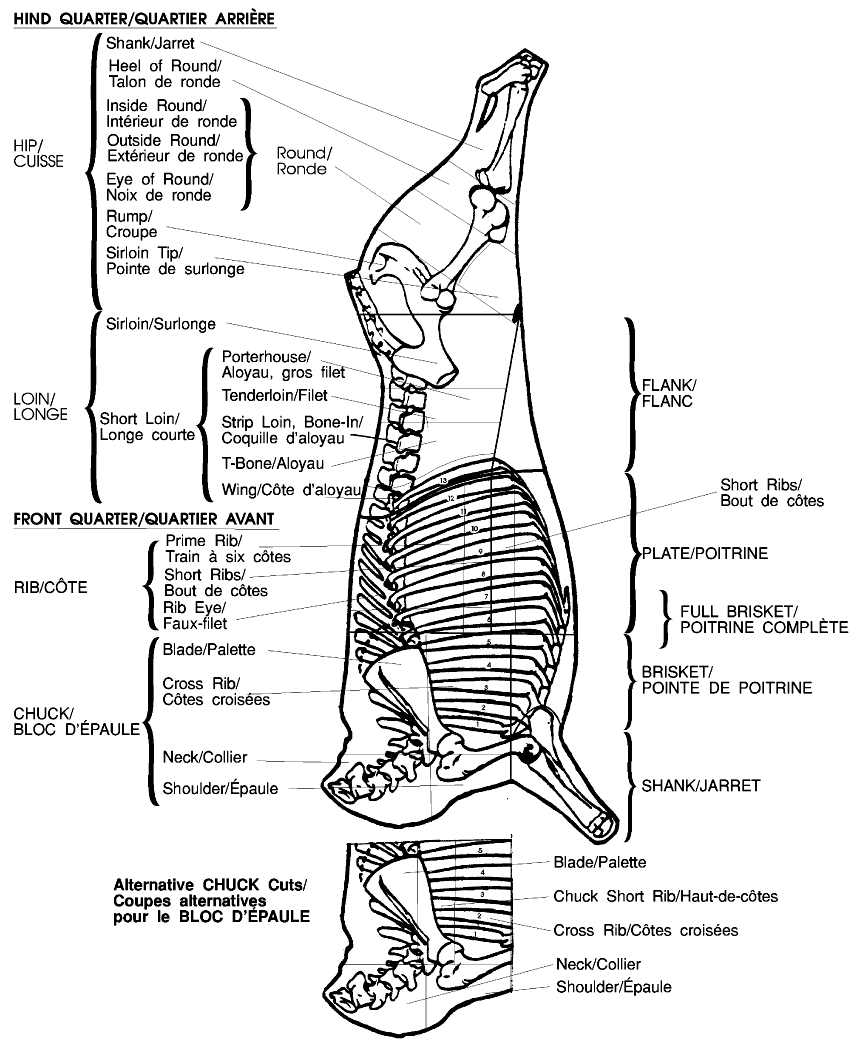
Clarification of photo – Diagram of meat cuts of a beefiness
This diagram shows the meat cuts from a piece of beef. The hind quarter consists of the hip, the loin and the flank.
- The hip consists of the following cuts:
- shank
- heel of circular
- round – which consists of within circular, outside round, middle of round
- rump
- siroin tip
- The loin consists of the following cuts:
- sirloin
- short loin – which consists of porterhouse, tenderloin, strip loin, T-bone, and wing
- The front quarter consists of rib, chuck, shank, brisket, full brisket, and plate.
- The rib consists of the following cuts:
- prime rib
- short ribs
- rib eye
- The chuck consists of the post-obit cuts:
- blade
- cross rib
- cervix
- shoulder
- The plate consists of short ribs.
- Culling chuck cuts consist of the post-obit:
- bract
- chuck brusque rib
- cervix
- shoulder
Beef – Skeletal diagram
Click on image for larger view
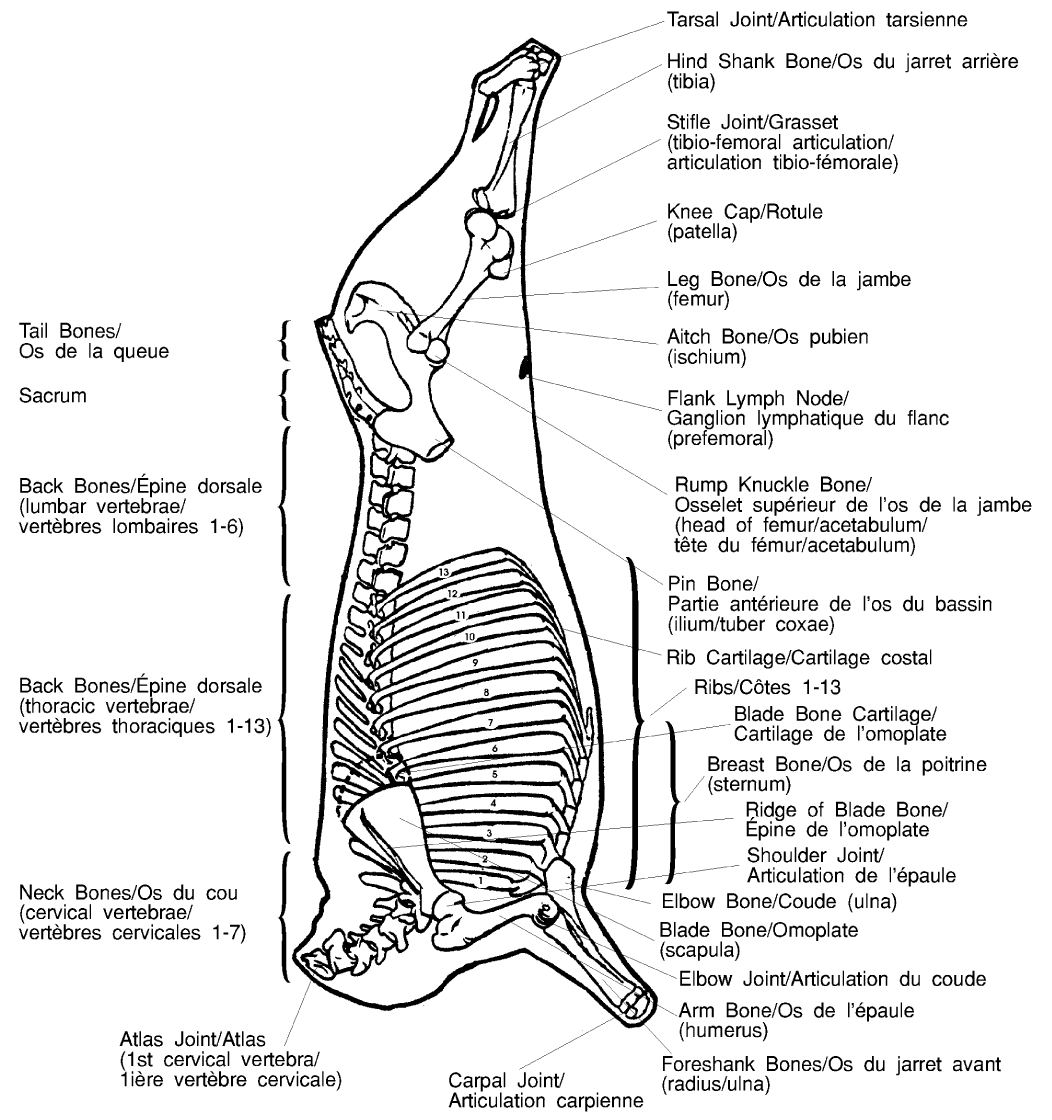
Description of photo – Diagram of meat cuts – Beefiness skeletal diagram
This diagram shows the skeletal view of a piece of beef.
The beef consists of:
- tail bones
- sacrum
- back basic (lumbar vertebrae 1-6)
- back bones (thoracic vertebrae i-13)
- cervix bones (cervical vertebrae)
- atlas (1st cervical vertebra)
- carpal articulation
- foreshank bones (radius/ulna)
- arm os (humerus)
- elbow joint
- blade bone (scapula)
- elbow os (ulna)
- shoulder joint
- ridge of blade bone
- chest bone (sternum)
- blade bone cartilage
- ribs one-xiii
- rib cartilage
- pivot bone (ilium)
- rump knuckle bone (head of femur/acetabulum)
- flank lymph node (prefemoral)
- aitch os (ischium)
- leg os (femur)
- knee cap (patella)
- stifle joint (tibio-femoral articulation)
- hind shank bone (tibia)
- tarsal joint
Meat cut nomenclature and description
- Beef: is meat derived from dressed carcasses of bovine animals having a warm weight of 160 kg or more. It may be derived from male person or female animals or from steers.
- Dressed beef carcass: means a beef carcass from which the pare, caput, developed mammary glands and the feet at the carpal and tarsal joints have been removed and the carcass has been eviscerated and separate.
- Beef side: means one (1) of the two (2) approximately equal portions of a dressed beef carcass obtained past cutting from the tail to the neck along the median line.
- Front quarter: means the anterior portion of the beef side which is separated from the hind quarter by a cut passing betwixt the twelfth and 13th rib.

4.1 Chuck (square-cut chuck): means that portion of the forepart quarter which is separated from the rib, plate, brisket and shank by two (2) straight cuts at right bending to each other. The first cutting passes between the fifth and sixth rib and separates the chuck, brisket and shank from the rib and plate. The second cut passes at a point slightly above (dorsal to) the elbow joint (distal extremity of the humerus) and through the cartilaginous juncture of the commencement (1st) rib and sternum, and separates the chuck from the brisket and shank.
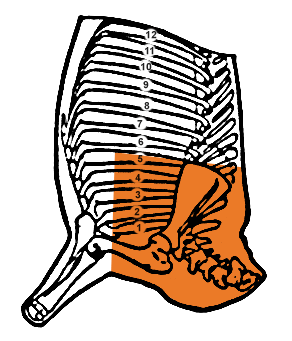
four.1.1 Shoulder clod: ways that large musculus mass of the chuck which lies outside (lateral side) of the blade os and ventral to the ridge of the blade bone extending from the shoulder joint to the tip of the bract os cartilage. It is obtained past ii (2) chief straight cuts approximately parallel to each other. The first cut passes along the ventral side of the ridge of the blade bone and the other over the ribs.
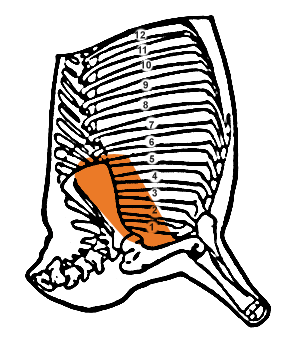
4.1.ane.1 Tiptop blade: means the portion of the shoulder clod including the muscles infraspinatus, triceps brachii and deltoideus found outside (lateral side) of the blade bone (scapula).
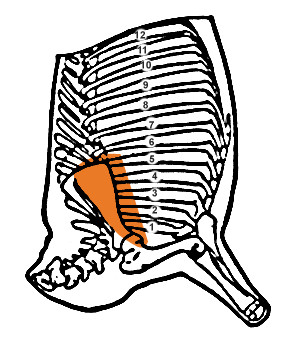
four.i.i.ii Top bract portion: ways that round shaped muscle (supraspiratus) of the bract which lies outside (lateral of side) of the blade os (scapula) and dorsal to the ridge of the blade os or the infraspiratus muscle which lies outside of the bract bone and ventral to the ridge of the blade os. They are separated from the blade bone and side by side muscles through natural seams.
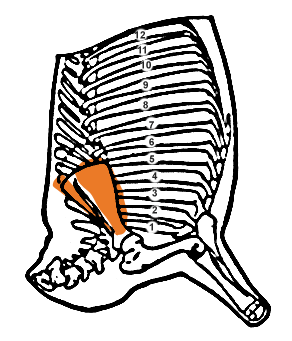
four.ane.2 Blade: means that portion of the chuck which is separated from the cervix, cross rib and shoulder by two (2) direct cuts at right angles to each other. The outset cut passes at a point slightly in front of (anterior to) the shoulder joint and the inductive tip of the bract os (scapula) thereby separating the neck and shoulder from the blade and cross rib. The second cutting passes through the interior edge of the 7th (7th) neck bone (cervical vertebra) and through the blade bone (scapula) separating the cervix from the shoulder and the bract from the cantankerous-rib.
Note: The blade may contain small portions of the 5th and sixth neck bones (cervical vertebrae).
four.1.2.ane Bottom bract (within bract): means the portion of the bract located within (medial side) of the bract bone (scapula) including the muscles teres major, subscapularis and serratus ventralis.
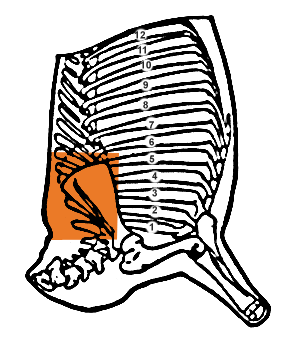
4.1.3 Neck: ways that portion of the chuck that is separated from the blade, cantankerous rib and shoulder as described in item 4.i.i.
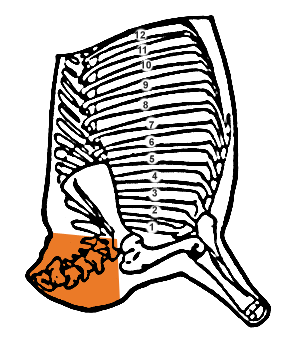
4.1.four Cross rib: means that portion of the chuck which is separated from the blade, cervix and shoulder equally described in item 4.1.one.
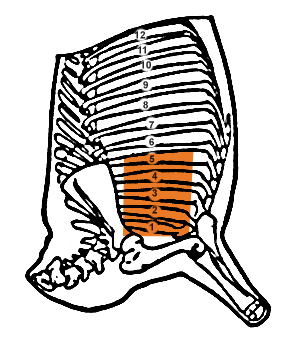
4.1.5 Shoulder: ways that portion of the chuck which is separated from the cross rib, blade and neck as described in item 4.1.1.

4.1.6 Chuck curt rib: is an culling portion of the chuck. It is separated from the neck and shoulder as described in item 4.ane.1 and from the blade by a straight cut passing on the superior edge of the body of the seventh neck bone (cervical vertebra) and through the center of the blade bone (scapula) and from the cross rib by a straight cutting passing below (ventral to) the anterior tip of the blade bone (scapula) and in proximity to the shoulder articulation.
Notation: The blade and cross rib portions resulting from the removal of the chuck brusque rib are alternative portions of the chuck.
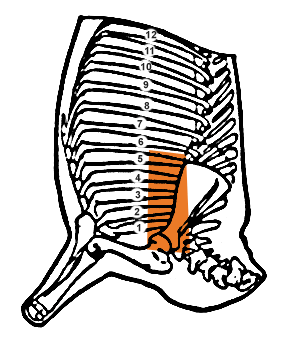
4.2 Rib (central rib): means that portion of the front quarter which is separated from the chuck and brisket by a straight cut passing between the 5th and sixth rib and from the plate past a direct cut passing across the ribs at correct angles to the first cutting at a point slightly below (ventral to) the middle of the rib cage.
Notation: This cut includes seven (seven) ribs (6th to twelfth inclusive) and may contain a small portion of the blade bone (scapula) and cartilage. It should not exist confused with prime number rib, which includes half-dozen ribs (7th to 12th).
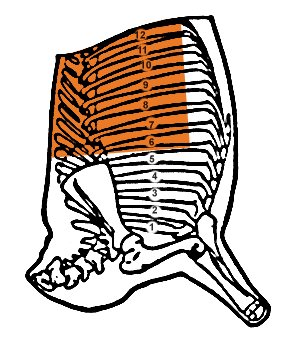
4.2.i Rib heart: means that boneless portion of the rib containing the big circular-shaped muscle (longissimus dorsi) located at the vertebral end of the ribs. Information technology may contain the closely adjacent muscle, spinalis dorsi.
Note: The term boneless rib should exist used if any other muscles are nowadays.
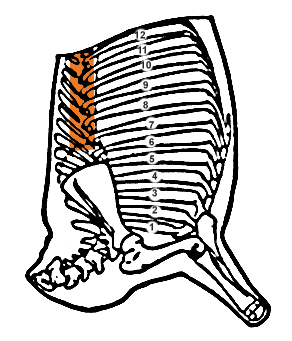
four.2.2 Short ribs (short braising ribs): is the rib end portion of the rib and plate obtained by making a straight cut parallel and adjacent to the cut which separates the rib from the plate.
Note: Short ribs incorporate no rib cartilage (costal cartilage).

4.2.iii Prime rib: is an alternative portion of the rib and refers to the portion containing the posterior six (6) ribs (7th to 12th inclusive).
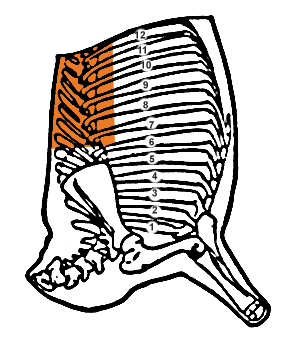
four.3 Plate: means that portion of the front quarter which is separated from the chuck and brisket by a straight cut passing between the fifth and sixth rib and from the rib by a straight cut passing across the ribs at right angles to the first cutting at a point slightly below (ventral to) the eye of the rib cage.
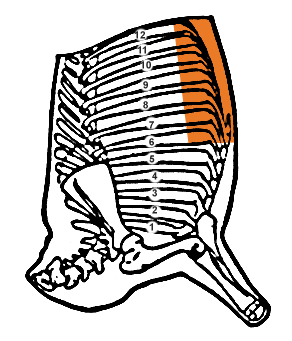
4.four Brisket (brisket point): means that portion of the front end quarter which is separated from the plate by a directly cutting passing between the fifth and sixth rib, from the chuck by a cutting at a correct angle to the first cut passing at a signal slightly above (dorsal to) the elbow joint (distal extremity of the humerus) and from the shank by a cut which follows the natural contour of the elbow bone (olecranon process of the ulna).
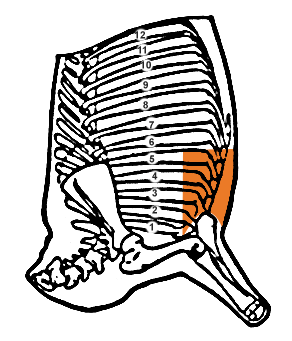
4.five Total brisket (full plate): refers to the portion containing both the brisket and plate.
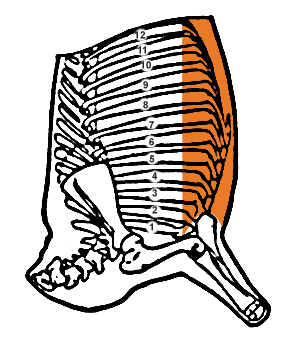
4.6 Shank (foreshank): ways that portion of the front quarter which is separated from the chuck by a cut passing at a point slightly above (dorsal to) the elbow joint (distal extremity of the humerus) and from the brisket by a cut which follows the natural seam of the elbow bone (olecranon process of the ulna).
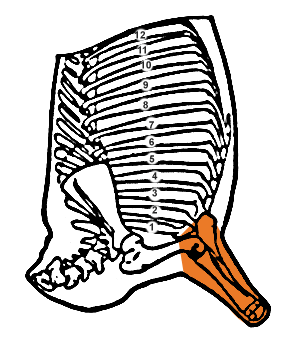
five. Hind quarter: ways the posterior portion of the beefiness side which is separated from the front quarter by a cut passing between the 12th and 13th rib.
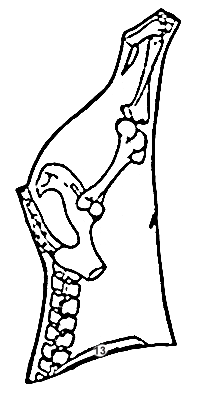
five.1 Flank: ways that portion of the hind quarter which is separated from the loin by a straight cut passing approximately parallel to the lumbar back bones (lumbar vertebrae) showtime in close proximity to or through the flank lymph node (prefemoral) and from the plate by a cut passing between the 12th and 13th rib and cartilage.

5.2 Loin (long loin): means that portion of the hind quarter which is separated from the flank as described in particular 5.1, from the sirloin tip (meet v.3.5) and from the hip by a cut which passes in front of (anterior to) the rump knuckle bone (head of the femur/acetabulum) thereby cutting the pelvic bone (os coxae) into approximately two equal parts.
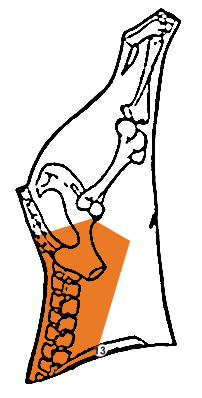
5.ii.1 Short loin: means the inductive portion of the loin which is separated from the sirloin by directly cut which passes at a signal immediately in front of (anterior to) the pin bone (ilium or tuber coxae).
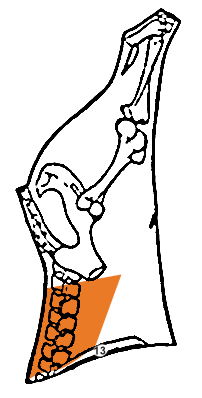
5.two.1.i Porterhouse: means that portion of the short loin which is separated from the T-bone by a straight cut passing immediately in front end of (anterior to) the tip of the gluteus medius musculus and approximately through the centre of the body of the fourth lumbar vertebra.
Note: Porterhouse may also be referred to every bit T-bone, yet T-bone, as described, may not be referred to as porterhouse.
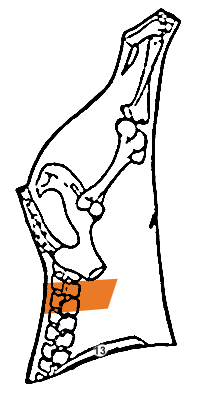
v.2.1.2 T-bone: ways that portion of the short loin which is separated from the porterhouse every bit described in item 5.2.1.1, and from the wing past a cut passing approximately through the centre of the body of the 1st lumbar vertebra and forth the dorsum (posterior) side of the last rib (13th rib).
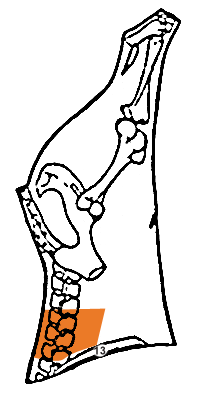
5.2.1.three Wing: means that portion of the short loin which is separated from the T-bone as described in item 5.2.1.ii. Information technology includes the 13th rib or part thereof.
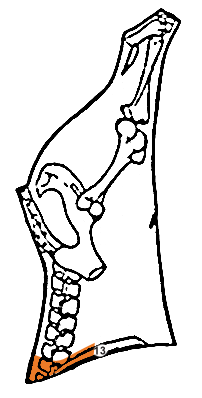
v.ii.1.4 Tenderloin: means the cylindrically shaped main muscle (psoas major and small) located on the inside (ventral side) of the loin.
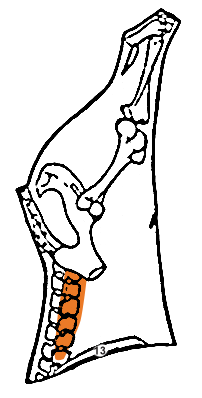
5.ii.1.v Strip loin, bone-in (shell loin): means that portion of the brusque loin from which the tenderloin has been removed. It contains portions of the intestinal muscles: obliquus abdominis externus; obliquus abdominis internus; transversus abdominis and loin muscles; gluteus medius; longissimus dorsi; and multifidus dorsi, or portions thereof.
Click on epitome for larger view
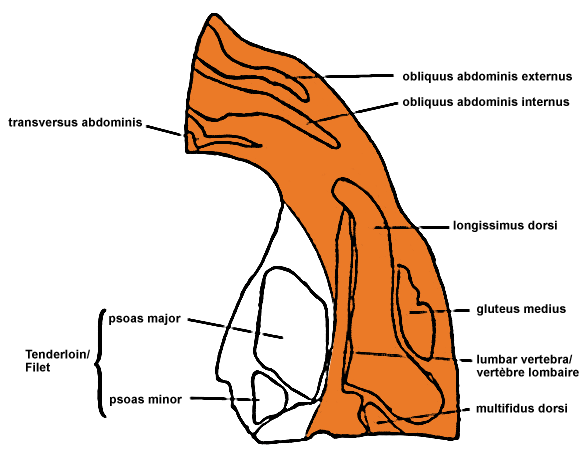
Clarification of photo – Diagram of the cantankerous-section of a loin
This diagram shows the cross-section of a loin.
The cross-section of a loin consists of:
- transversus abdominis
- tenderloin – which consists of psoas major and psoas minor
- multifidus dorsi
- lumbar vertebra
- gluteus medius
- longissimus dorsi
- obliquus abdominis internus
- obliquus abdominis externus
5.2.1.6 Strip loin: means that portion of the short loin from which the tenderloin and bones have been removed. Information technology contains 3 (3) muscles: gluteus medius; longissimus dorsi; and multifidus dorsi, or portions thereof.
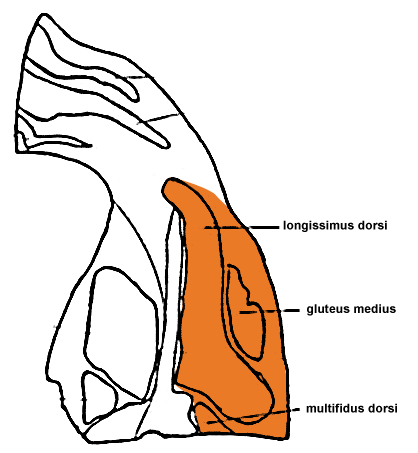
5.2.two Sirloin: means the posterior portion of the loin which is separated from the short loin by a direct cut which passes at a indicate immediately in front of (anterior to) the pivot bone (ilium or tuber coxae).
5.ii.two.1 Sirloin, tenderloin removed: ways the sirloin from which the tenderloin is removed.

5.2.2.2 Top sirloin: means the dorsal portion of the sirloin which includes the gluteus medius and may include the biceps femoris.
five.2.2.3 Elevation sirloin, cap removed (top sirloin portion): means the top sirloin from which the biceps femoris is removed.

5.2.2.4 Bottom sirloin: means the ventral portion of the sirloin which includes the muscle tensor fasciae latae.
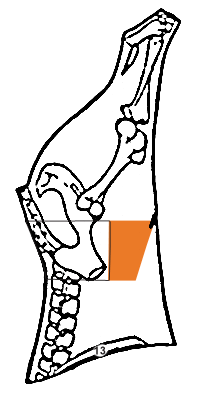
5.three Hip: means that portion of the hind quarter which is separated from the loin past a straight cut which passes in front of (inductive to) the rump knuckle bone (head of the femur/acetabulum) thereby cutting the pelvic bone (os coxae) into approximately two (2) equal parts.
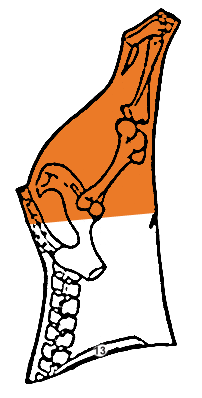
5.3.one Rump: means that portion of the hip which is separated from the round by a straight cut passing approximately parallel and in proximity to the aitch bone (ischium) leaving no portion of the aitch bone (ischium) in the round.
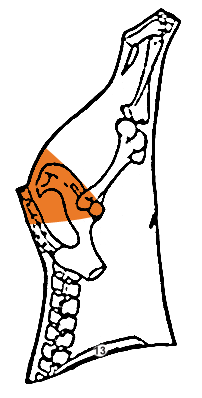
5.3.2 Round (full circular): means that portion of the hip which is separated from the rump as described in item 5.3.ane, from the sirloin tip by a straight cutting which passes at a point in front of (anterior to) the shaft of the leg bone (femur) and from the heel of circular by a direct cutting which passes through the base of operations of the shaft of the leg os (distal extremity of the femur). The cutting may extend into the rump.
Annotation: The circular contains no role of the gastrocnemius muscle.
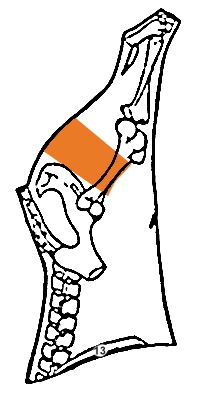
5.3.2.1 Inside round: ways that boneless portion of the circular located within (medial side) of the leg, which is separated from the outside circular past cutting lengthwise along the natural seam. The cut may extend into the rump. Information technology contains iv (4) muscles, namely: pectineus, adductor, gracilis and semimembranosus.

Clarification of photograph – Diagram of a cross-department of an inside round
This diagram shows the cross-section of an inside round.
The cantankerous-department of an inside round consists of:
- femur
- pectineus
- gracilis
- adductor
- semimembranosus
5.three.ii.two Outside round: means that boneless portion of the round located exterior (lateral side) of the leg, which is separated from the inside round as described. The cut may extend into the rump. It contains iii (3) master muscles, namely: vastus lateralis, biceps femoris and semitendinosus. Information technology may exclude the eye of circular (semitendinosus).
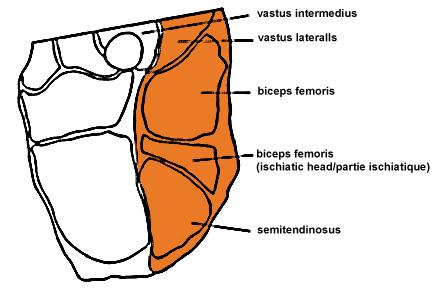
Description of photo – Diagram of a cross-department of an outside round
This diagram shows the cross-section of an outside round.
The cross-section of an outside round consists of:
- vastus intermedius
- vastus lateralis
- biceps femoris
- beceps femoris (ischiatic head)
- semitendinosus
5.3.2.3 Middle of round: ways the round shaped musculus (semitendinosus) found at the outer (posterior) extremity of the outside round and extends into the rump.
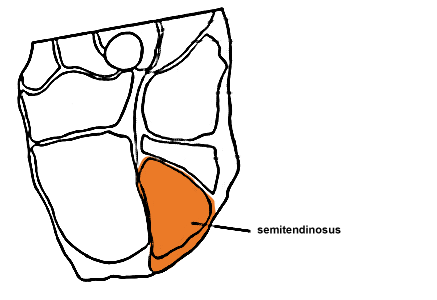
v.3.2.4 Round, eye removed: ways a total circular excluding the center of round.

5.3.iii Heel of round: ways that portion of the hip which is separated from the round by a straight cut which passes through the base of the shaft of the leg os (distal extremity of the femur) and from the shank by a straight cutting passing through the stifle articulation (tibio-femoral articulation).
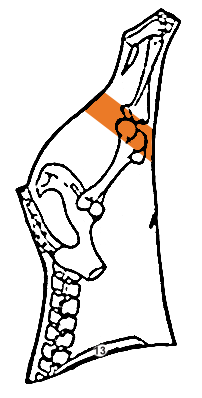
5.3.4 Shank (hind shank): means that portion of the hip which is separated from the heel of round by a directly cut passing through the stifle joint (tibio-femoral articulation).
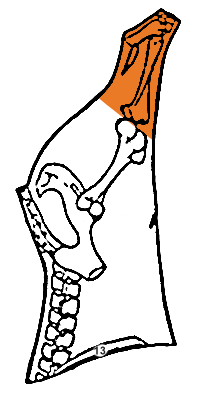
5.three.5 Sirloin tip: ways that portion of the hip obtained past a "V-shaped" cut first approximately at the knee cap (patella) following the full length of the leg bone (femur) up to the vicinity of the rump knuckle os (head of femur/acetabulum) then towards the flank lymph node (prefemoral). Information technology contains three (iii) chief muscles, namely: vastus lateralis, rectus femoris and vastus medialis.
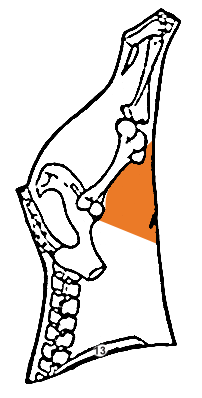
5.3.v.1 Eye of sirloin tip: means the triangular-shaped muscle (vastus lateralis) located outside (lateral side) of the sirloin tip.
v.3.5.ii Sirloin tip, eye removed: ways the sirloin tip excluding the middle of sirloin tip.

Description of photograph – Diagram of a cross-department of a sirloin tip
This diagram shows the cross-department of a sirloin tip.
The cross-section of a sirloin tip consists of:
- tensor fasciae latae
- rectus femoris
- vastus medialis
- vastus lateralis
- vastus intermedius
Variety meats
- Brain / Cervelle
- Heart / Coeur
- Kidney / Rognon
- Liver / Foie
- Tail / Queue
- Tongue / Langue
- Tripe / Tripe
- Suet / Suif
- Sweetbread / Ris
Suet: ways fresh fatty tissue obtained from the omentum and kidney region of a dressed beef carcass.
List of meat cut modifiers
- Bone in / De coquille
- Boneless / Désossé
- Butterfly (ied) / Papillon
- Cap removed / Paré
- Delicatize(d) / Attendri(re) mécaniquement
- Diced Beefiness / Boeuf en cubes
- Kabob / Brochette
- Medallion / Médaillon
- Minute steak / Bifteck minute
- Portion / Partie du
- Pot roast / Morceau à braiser
- Roast beef / Rosbif
- Rolled / Roulé
- Semi-boneless / Semi-désossé
- Steak / Bifteck, steak, tranche
- Stewing beef / Boeuf à ragoût
- Tenderize(d) / Attendri(re)
- Tied / Ficelé
- Tournedos / Tournedos
- Trimmed / Paré
Note: While not required, these modifiers may be used to describe beef cuts provided they are informative and not misleading.
- Appointment modified:
Source: https://inspection.canada.ca/food-label-requirements/labelling/industry/meat-and-poultry-products/meat-cuts/beef/eng/1348582373896/1348589471777?wbdisable=true